Born Haber cycle helps to determine lattice enthalpy of ionic compound as well as electron gain enthalpy of different elements. Based on the diagram drawn, answer the questions given below.

What is the lattice enthalpy for the formation of MgCI2?
−20kJ
−40kJ
−15kJ
+40kJ
The correct Answer is:A
Mg2+(g)+2CI−(g)→MgCI2(s)ΔHL.E=?CI2(g)→2CI(g)[30−5=25]2CI(g)→2CI−(g)[10−30=−20]Mg(g)→Mg+(g)[135−10=25]Mg+(g)→Mg2+(g)[40−35=5]Mg(s)+CI2(g)→MgCI2(s)[20−0=20]Mg(s)→Mg(s)[5−0=5]

Topper's Solved these Questions
- PERIODIC TABLEBook:GRB PUBLICATIONChapter:PERIODIC TABLEExercise:Comprehension 18
Explore 1 Video
- PERIODIC TABLEBook:GRB PUBLICATIONChapter:PERIODIC TABLEExercise:Comprehension 19
Explore 1 Video
- PERIODIC TABLEBook:GRB PUBLICATIONChapter:PERIODIC TABLEExercise:Comprehension 16
Explore 1 Video
- NOMENCLATURE AND CLASSIFICATIONBook:GRB PUBLICATIONChapter:NOMENCLATURE AND CLASSIFICATIONExercise:Subjective Type
Explore 24 Videos
- PRACTICAL ORGANIC CHEMISTRYBook:GRB PUBLICATIONChapter:PRACTICAL ORGANIC CHEMISTRYExercise:Exercise 4 (Matrix match type )
Explore 1 Video
Similar Questions
The first and second ionization enthalpies and electron gain enthalpy of some elements are as given below:
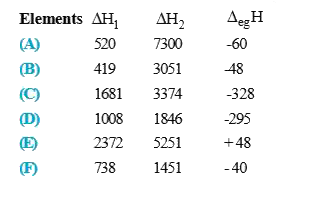
Which of these elements is the least reactive non-metal?
View SolutionIn the Born- Haber calculation of the lattice enthalpy of LiF from its elements , which process is exothermic?
View Solution
Knowledge Check
Born Haber cycle helps to determine lattice enthalpy of ionic compound as well as electron gain enthalpy of different elements. Based on the diagram drawn, answer the questions given below.

What is the electron gain enthalpy of CI(g)?A−5kJB−25kJC−20kJD−10kJBorn Haber cycle helps to determine lattice enthalpy of ionic compound as well as electron gain enthalpy of different elements. Based on the diagram drawn, answer the questions given below.

What is the value of IE1 of Mg+IE1 of Mg+?A25 kJB5 kJC30 kJD20 kJThe first and second ionization enthalpies and electron gain enthalpy of some elements are as given below:
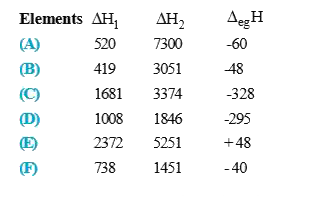
Which of the elements given above is the least reactive?A(C)B(D)C(E)D(F)
The first and second ionization enthalpies and electron gain enthalpy of some elements are as given below:
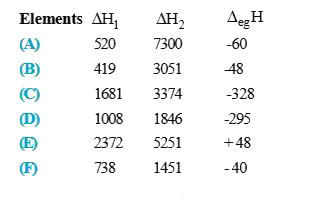
Which of these elements is the most reactive metal?
View SolutionThe first and second ionization enthalpies and electron gain enthalpy of some elements are as given below:
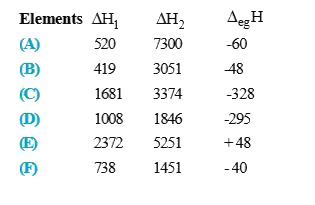
Which of these elements is the most reactive non-metal?
View SolutionAn ionic bond is formed between two atoms if the sum of their lattice enthalpy and electron gain enthalpy is greater than
View SolutionThe first and second ionization enthalpies and electron gain enthalpy of some elements are as given below:
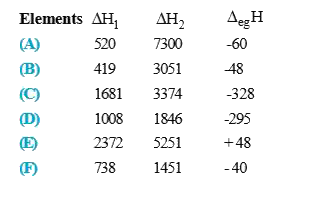
A metal which can form a stable binary halide of the type MX2 is (X : Halogen)
View SolutionThe first and second ionization enthalpies and electron gain enthalpy of some elements are as given below:
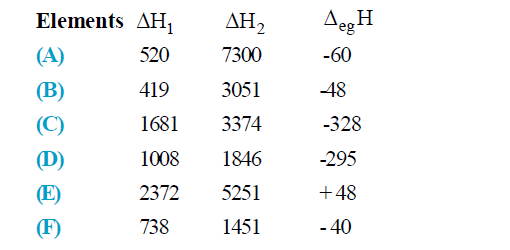
A metal which can form a stable binary halide of the type MX2 is (X : Halogen)
View Solution

